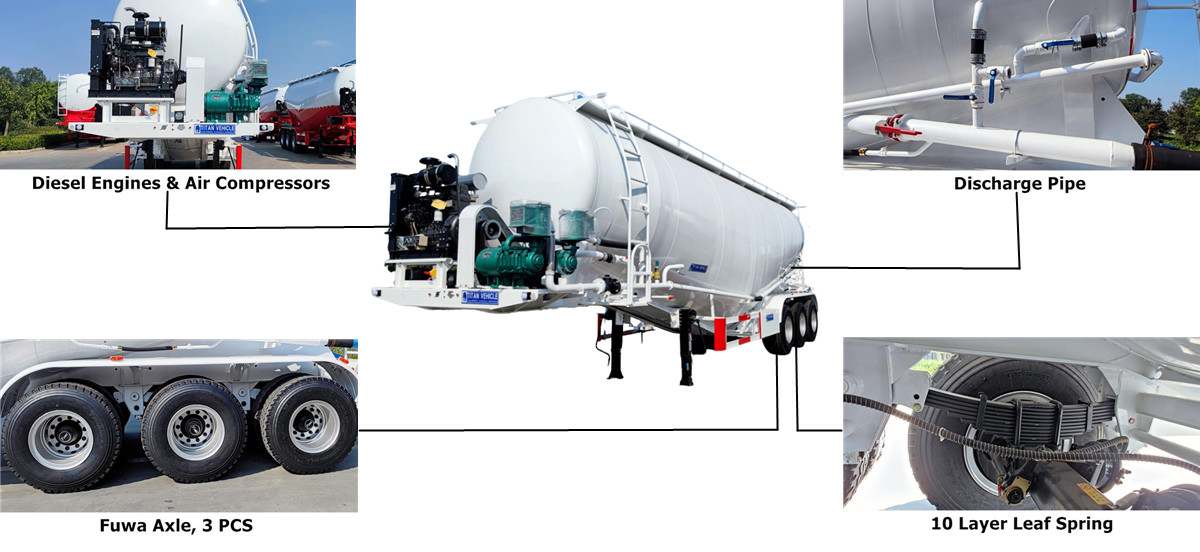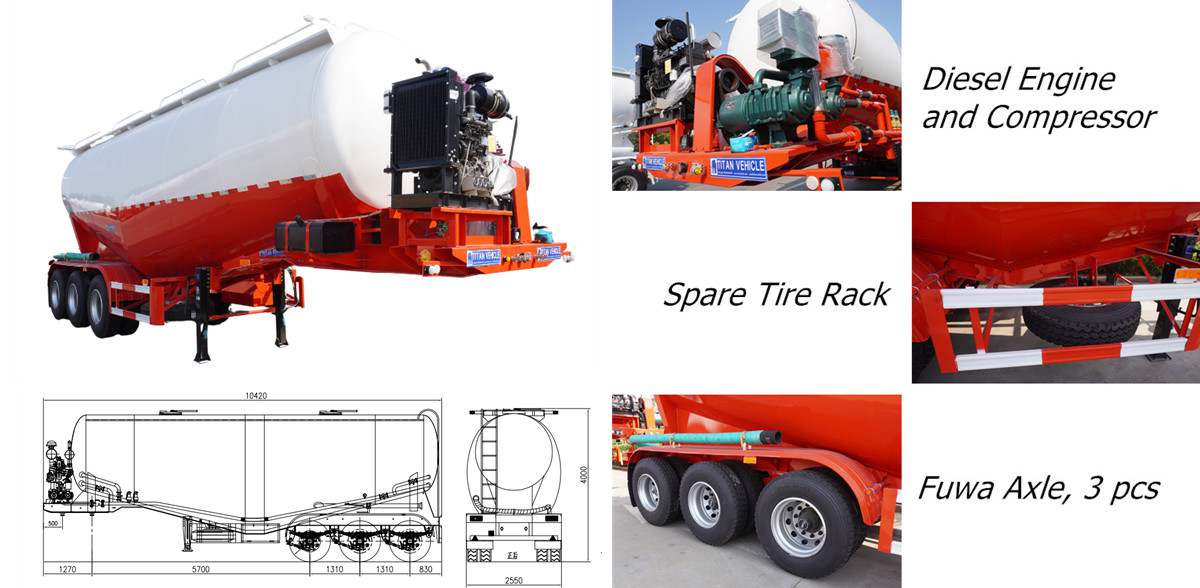Chapter 1: What is cement bulk trailer?
Chapter 2: How is cement transported in bulk?
Chapter 3: What is the capacity of cement bulk carrier trailer?
Chapter 4: What is the purpose of the bulk trailer?
A cement bulk trailer, also known as a cement bulk carrier or cement trailer for sale, is a specialized vehicle designed to transport bulk quantities of cement in a dry, powdery form. Here are some key features and characteristics of cement bulk trailers:
1. Construction: Cement trailer for sale is made from lightweight yet strong materials, such as aluminum or high-strength steel, to maximize payload capacity while minimizing weight.
2. Design: Pneumatic cement carrier trailer usually equipped with multiple compartments to transport different types of dry bulk material or to segregate different grades of cement. This helps in efficient loading and unloading.
3. Pneumatic System: Cement bulk trailers often utilize a pneumatic system for both loading and unloading the cement. Air pressure is used to displace the cement from the trailer into storage silos or directly into a mixing truck.
4. Capacity: Cement bulk carrier trailers can carry large volumes of cement, typically ranging between 20 to 40 tons, depending on the design and local regulations.
5. Loading & Unloading: Cement bulk trailers are loaded through a top opening using pneumatic systems and unloaded through bottom discharge valves, allowing for efficient handling of the product.
6. Dust Control: Many modern cement bulk trailers are equipped with dust control systems to minimize emissions and ensure compliance with environmental regulations.
7. Safety Features: Pneumatic trailers for sale often come with safety features like pressure relief valves and monitoring systems to ensure safe transportation of the bulk materials.
8. Applications: Cement bulk trailers are commonly used in the construction industry for delivering cement to construction sites, ready-mix concrete plants, and other locations where bulk cement is needed.
Overall, cement bulk trailers are essential to the logistics of the construction industry, allowing for efficient and safe transportation of one of the most critical building materials.

Using a cement trailer involves several steps, from preparation to unloading. Here’s a general guide on how to use a cement trailer effectively and safely:
1. Pre-Trip Inspection
- Check the Trailer: Inspect the cement trailer for any damages, such as leaks, cracks, or issues with the pneumatic system.
- Ensure Safety Features: Verify that the brakes, lights, and tires are in proper working condition.
- Review Tare Weight: Ensure the tare weight (the weight of the empty trailer) is noted for accurate load calculations.
2. Loading the Cement
- Visit the Cement Plant: Drive the trailer to the designated loading area at the cement plant.
- Pneumatic Loading System: Connect the trailer to the loading equipment. This usually involves a hose that connects the plant’s pneumatic system to the trailer. Activate the loading system, ensuring the trailer’s air compressors are sealed to prevent spillage.
- Monitor Loading: Keep an eye on the loading process to prevent overloading or spillage. Make sure the trailer is filled according to the weight limit.
3. Securing the Load
- Check Seals: Ensure that all trailers’ hatches and seals are secured tightly to prevent any loss of material during transport.
- Weight Distribution: Make sure the cement is evenly distributed to maintain stability while driving.
4. Transporting the Cement
- Drive Safely: Follow all traffic regulations and be cautious on the road. Remember that the added weight can affect braking and handling.
- Avoid Sudden Maneuvers: Drive smoothly to minimize the risk of shifting the load.
5. Arriving at the Destination
- Locate Unloading Area: Drive to the designated unloading area, typically at a construction site or a concrete batching plant.
- Setup for Unloading: Ensure that the area is clear and that you have access to the unloading equipment.
6. Unloading the Cement
- Connect Unloading System: Connect the trailer to the unloading equipment (usually a pneumatic system). Properly set up the trailer to direct the cement to the appropriate location.
- Activate Unloading: Pressurize the system to start the unloading process. Monitor the process to ensure everything runs smoothly and adjust as necessary. After unloading, ensure that no cement is left in the trailer. This is important for cleanliness and efficient future loads.
7. Post-Trip Actions
- Clean the Trailer: Remove any residual cement from the trailer’s interior to prevent buildup.
- Inspect Again: Check for any damage or maintenance needs after unloading.
- Document Trip: Log the load details, time, and any issues encountered during transport for record-keeping.
8. Maintenance Tips
- Regular Maintenance: Schedule routine inspections and maintenance for the trailer to ensure optimal performance.
- Stay Informed: Keep up with safety practices and operational guidelines for handling cement trailers.
By following these steps, you can use a cement trailer effectively and ensure safe transportation of your load. Happy hauling!

The capacity of a cement bulk carrier trailer typically ranges from about 30 to 70 tons, which is equivalent to approximately 25 to 60 cubic meters of cement. However, the exact capacity can vary depending on the design and manufacturer of the cement bulk carrier trailer.
The capacity of a cement bulk carrier trailer is influenced by several key factors:
1. Design and Structure: The cement bulk carrier trailer's design, including its length, width, and height, determines the overall volume that can be filled with cement. Structural materials and engineering also play a role in how much weight the trailer can support.
2. Weight Limit Regulations: Local, regional, and national regulations impose weight limits on vehicles that can vary by jurisdiction. These limits directly impact how much cement can be transported.
3. Material Density: Different types of cement have varying densities. The more dense the material, the heavier it is for the same volume, affecting the total weight that can be loaded.
4. Trailer Configuration: Some cement bulk carrier trailers are designed with multiple compartments, allowing for the transportation of different types of materials or varying amounts of a single material. This configuration can affect capacity.
5. Safety Considerations: Safety features, such as the need to leave space for load shifting during transport, may limit the maximum capacity that can be loaded.
6. Tire and Axle Specifications: The specifications of tires and axles determine how much weight the cement bulk carrier trailer can effectively carry and distribute on the road.
7. Shipping and Handling Efficiency: Some cement bulk carrier trailers are designed for easier loading and unloading, which can influence capacity in terms of how materials can be stored and managed.
These factors combined dictate the maximum capacity of a cement bulk carrier trailer.

The purpose of a bulk cement trailer is to transport bulk quantities of cement from production facilities to various construction sites, ready-mix concrete plants, and other locations that require cement as a key building material. Here are some specific purposes and advantages of using a bulk cement trailer:
1. Efficient Transportation: Bulk cement trailers allow for the transportation of large volumes of cement in a single trip, improving logistical efficiency and reducing transportation costs.
2. Cost-Effective: By transporting cement in bulk, construction companies and suppliers can significantly lower the cost per ton compared to smaller packaging options, like bags.
3. Safe Handling: Bulk trailers are designed with pneumatic systems to load and unload cement safely, minimizing dust exposure and ensuring compliance with safety regulations.
4. Versatile Use: They can deliver different types of dry bulk materials (not just cement), allowing for flexibility in operations.
5. Time-Saving: The efficiency of loading and unloading processes helps streamline timelines for construction projects, ensuring that materials are available when needed.
6. Environmental Considerations: With features to control dust emissions, bulk cement trailers help reduce environmental impact during transportation.
7. Adaptability: Many bulk cement trailers can be equipped with technology for monitoring load and discharge, enhancing management and tracking of materials.
In summary, the bulk cement trailer plays a crucial role in the construction industry, ensuring the effective, safe, and economical delivery of one of its most essential materials.